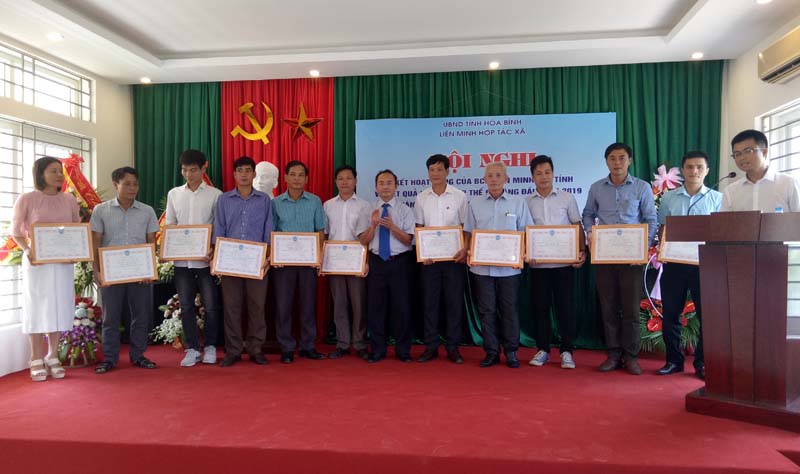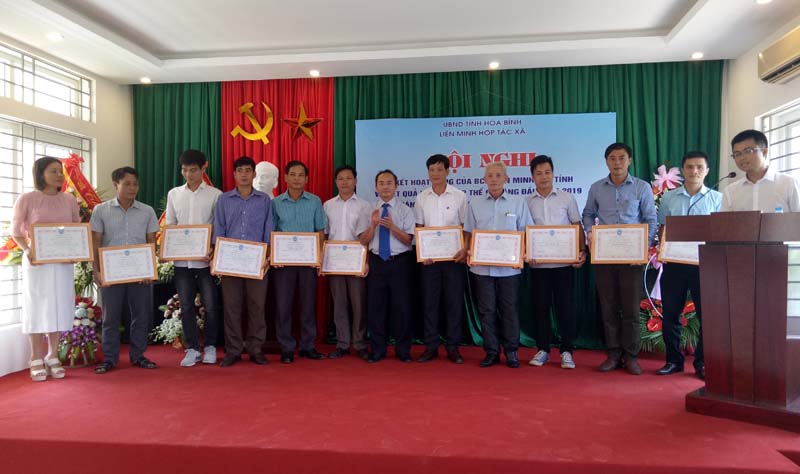
(HBO) – The Hoa Binh Cooperative Alliance has held a conference to review its performance in the first half of 2019 and deploy tasks for the remaining months.
 The Hoa Binh Cooperative Alliance presents
certificates of membership to 12 newly-admitted cooperatives.
The Hoa Binh Cooperative Alliance presents
certificates of membership to 12 newly-admitted cooperatives.
According to the
provincial cooperative alliance’s report, Hoa Binh currently has 222
cooperative groups and 324 cooperatives. In the first six month of the year, 21
new cooperatives was established while eight others were resolved and seven temporarily suspendedtheir operations.
Theexisting cooperatives have a total
of over 11,505 members,
mostly households, and creates jobs for nearly 20,130 workers.
The cooperatives’
total charter capital exceeded 642 billion VND with capital averaging 2.2
billion VND each. The charter capital accounted for about 50 percent of their
operating capital.
Sale revenues
from goods and services averaged
nearly 1.59 billion VND per cooperative, about 65 percent of which came from
transactions among cooperative members.
Average profit
was estimated at 197 million VND each cooperative and workers’ monthly wage was 3.8 million VND on average.
The alliance
reported that 58.2 percent of the cooperatives, or 169, are running
effectively. About 65.4 percent of communes in the province have established
cooperatives operated in various areas. The cooperatives’ management capacity
has been improved with an increase in the number of capable official personnel.
The conference
outlined ten key tasks for the remaining months of the year, including
continued promotion of collective economic development, adivising the
provincial People’s Committee to provide funding for new cooperatives
established in 2018 and 2019, continued implementation of six major projects
and plans on collective economic development, developing a plan to support
cooperatives in 2020, strengthening coordination among governmental agencies
and departments in managing and supporting collective economic development./.
According to data from the Hoa Binh Provincial Party Committee, the industrial production index for the first six months of 2025 is estimated to have increased by 20% compared to the same period last year. This marks the highest year-on-year growth rate for this period since 2020.
In the first six months of 2025, Hoa Binh province’s export turnover was estimated at 1.145 billion USD, marking an 18.11% increase compared to the same period in 2024. Import turnover was estimated at $ 804 million, a 17.15% increase, which helped the province maintain a positive trade balance.
The lives of the ethnic minority farmers in Tan Lac district have gradually improved thanks to the new directions in agricultural production. This is a testament to the collective strength fostered through the professional associations and groups implemented by various levels of the district’s Farmers’ Union.
With the motto the "product quality comes first,” after nearly one year of establishment and operation, Muong village’s Clean Food Agricultural and Commercial Cooperative, located in Cau Hamlet, Hung Son Commune (Kim Boi district), has launched reputable, high-quality agricultural products to the market that are well-received by consumers. The products such as Muong village’s pork sausage, salt-cured chicken, and salt-cured pork hocks have gradually carved out a place in the market and they are on the path to obtaining the OCOP certification.
In the past, the phrase "bumper harvest, rock-bottom prices" was a familiar refrain for Vietnamese farmers engaged in fragmented, small-scale agriculture. But today, a new spirit is emerging across rural areas of Hoa Binh province - one of collaboration, organisation, and collective economic models that provide a stable foundation for production.
Maintaining growing area codes and packing facility codes in accordance with regulations is a mandatory requirement for agricultural products to be eligible for export. Recently, the Department of Agriculture and Environment of Hoa Binh province has intensified technical supervision of designated farming areas and packing facilities to safeguard the "green passport" that enables its products to access international markets.



 The Hoa Binh Cooperative Alliance presents
certificates of membership to 12 newly-admitted cooperatives.
The Hoa Binh Cooperative Alliance presents
certificates of membership to 12 newly-admitted cooperatives.